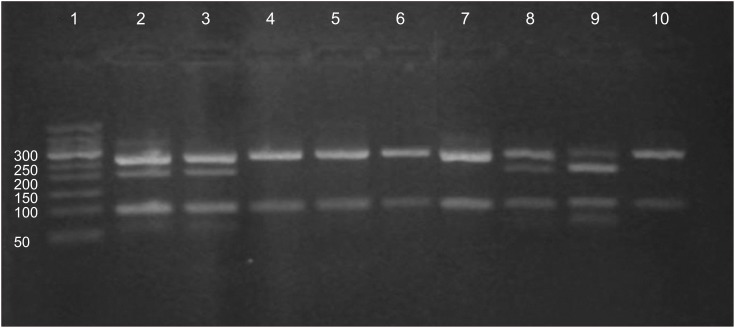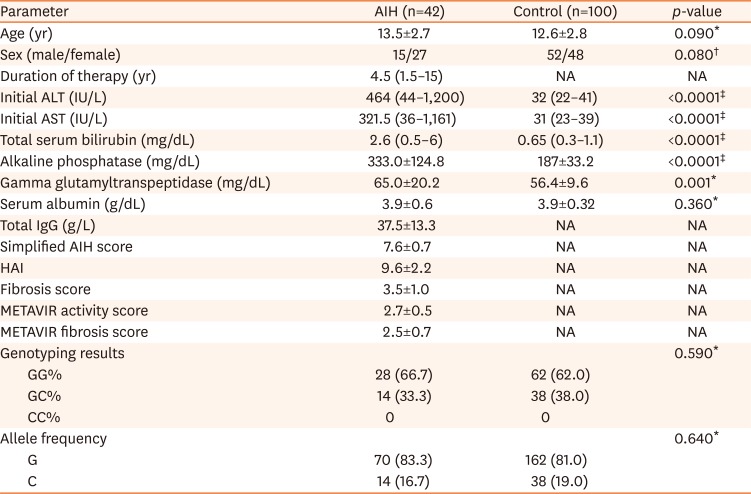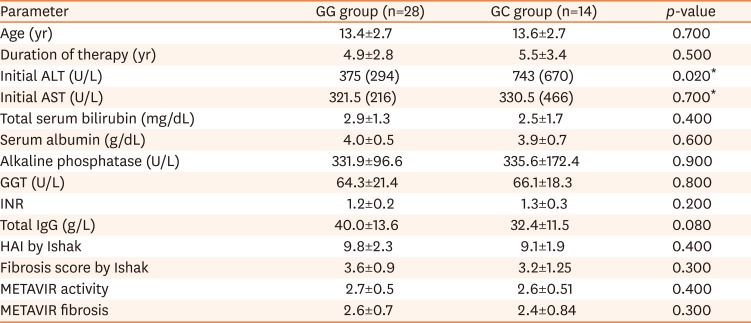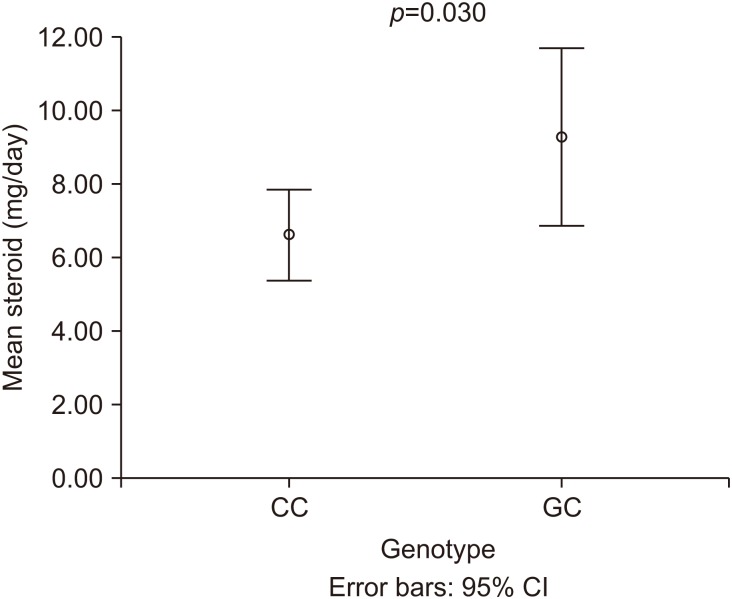1. Maggiore G, Veber F, Bernard O, Hadchouel M, Homberg JC, Alvarez F, et al. Autoimmune hepatitis associated with anti-actin antibodies in children and adolescents. J Pediatr Gastroenterol Nutr. 1993; 17:376–381. PMID:
8145091.

2. Mieli-Vergani G, Heller S, Jara P, Vergani D, Chang MH, Fujisawa T, et al. Autoimmune hepatitis. J Pediatr Gastroenterol Nutr. 2009; 49:158–164. PMID:
19561543.

3. Gregorio GV, Portmann B, Reid F, Donaldson PT, Doherty DG, McCartney M, et al. Autoimmune hepatitis in childhood: a 20-year experience. Hepatology. 1997; 25:541–547. PMID:
9049195.

4. Mieli-Vergani G, Vergani D. Autoimmune paediatric liver disease. World J Gastroenterol. 2008; 14:3360–3367. PMID:
18528933.

5. Czaja AJ, Menon KV, Carpenter HA. Sustained remission after corticosteroid therapy for type 1 autoimmune hepatitis: a retrospective analysis. Hepatology. 2002; 35:890–897. PMID:
11915036.

6. Czaja AJ. Difficult treatment decisions in autoimmune hepatitis. World J Gastroenterol. 2010; 16:934–947. PMID:
20180231.

7. de Boer YS, van Gerven NM, Zwiers A, Verwer BJ, van Hoek B, van Erpecum KJ, et al. Genome-wide association study identifies variants associated with autoimmune hepatitis type 1. Gastroenterology. 2014; 147:443–52.e5. PMID:
24768677.

8. Czaja AJ, Manns MP. Advances in the diagnosis, pathogenesis, and management of autoimmune hepatitis. Gastroenterology. 2010; 139:58–72.e4. PMID:
20451521.

9. Vergani D, Mieli-Vergani G. Aetiopathogenesis of autoimmune hepatitis. World J Gastroenterol. 2008; 14:3306–3312. PMID:
18528928.

10. Calandra T, Bernhagen J, Metz CN, Spiegel LA, Bacher M, Donnelly T, et al. MIF as a glucocorticoid-induced modulator of cytokine production. Nature. 1995; 377:68–71. PMID:
7659164.

11. Bucala R. MIF, MIF alleles, and prospects for therapeutic intervention in autoimmunity. J Clin Immunol. 2013; 33(Suppl 1):S72–S78. PMID:
22968741.

12. Assis DN, Leng L, Du X, Zhang CK, Grieb G, Merk M, et al. The role of macrophage migration inhibitory factor in autoimmune liver disease. Hepatology. 2014; 59:580–591. PMID:
23913513.

13. Assis DN, Takahashi H, Leng L, Zeniya M, Boyer JL, Bucala R. A macrophage migration inhibitory factor polymorphism is associated with autoimmune hepatitis severity in US and Japanese patients. Dig Dis Sci. 2016; 61:3506–3512. PMID:
27696094.

14. Hennes EM, Zeniya M, Czaja AJ, Parés A, Dalekos GN, Krawitt EL, et al. International Autoimmune Hepatitis Group. Simplified criteria for the diagnosis of autoimmune hepatitis. Hepatology. 2008; 48:169–176. PMID:
18537184.

15. Ishak K, Baptista A, Bianchi L, Callea F, De Groote J, Gudat F, et al. Histological grading and staging of chronic hepatitis. J Hepatol. 1995; 22:696–699. PMID:
7560864.

16. Roberts S, Leng L, Soroka CJ, Boyer JL, Bucala R, Assis DN. Macrophage migration inhibitory factor (MIF) modulates T-cell proliferation and hepatic inflammation in a model of autoimmune liver disease. J Hepatol. 2017; 66:S363–4.

17. Sreih A, Ezzeddine R, Leng L, LaChance A, Yu G, Mizue Y, et al. Dual effect of the macrophage migration inhibitory factor gene on the development and severity of human systemic lupus erythematosus. Arthritis Rheum. 2011; 63:3942–3951. PMID:
22127710.

18. Foote A, Briganti EM, Kipen Y, Santos L, Leech M, Morand EF. Macrophage migration inhibitory factor in systemic lupus erythematosus. J Rheumatol. 2004; 31:268–273. PMID:
14760795.
19. Llamas-Covarrubias MA, Valle Y, Bucala R, Navarro-Hernández RE, Palafox-Sánchez CA, Padilla-Gutiérrez JR, et al. Macrophage migration inhibitory factor (MIF): genetic evidence for participation in early onset and early stage rheumatoid arthritis. Cytokine. 2013; 61:759–765. PMID:
23402792.

20. Zhang H, Ma L, Dong LQ, Shu C, Xu JL. Association of the macrophage migration inhibitory factor gene--173G/C polymorphism with inflammatory bowel disease: a meta-analysis of 4296 subjects. Gene. 2013; 526:228–231. PMID:
23707797.
21. Berdeli A, Mir S, Ozkayin N, Serdaroglu E, Tabel Y, Cura A. Association of macrophage migration inhibitory factor -173C allele polymorphism with steroid resistance in children with nephrotic syndrome. Pediatr Nephrol. 2005; 20:1566–1571. PMID:
16133063.

22. Arikan C, Berdeli A, Ozgenc F, Tumgor G, Yagci RV, Aydogdu S. Positive association of macrophage migration inhibitory factor gene-173G/C polymorphism with biliary atresia. J Pediatr Gastroenterol Nutr. 2006; 42:77–82. PMID:
16385258.

23. Sadek KH, Ezzat S, Abdel-Aziz SA, Alaraby H, Mosbeh A, Abdel-Rahman MH. Macrophage migration inhibitory factor (MIF) gene promotor polymorphism is associated with increased fibrosis in biliary atresia patients, but not with disease susceptibility. Ann Hum Genet. 2017; 81:177–183. PMID:
28657145.

24. Akyildiz M, Gunsar F, Nart D, Sahin O, Yilmaz F, Akay S, et al. Macrophage migration inhibitory factor expression and MIF gene -173 G/C polymorphism in nonalcoholic fatty liver disease. Eur J Gastroenterol Hepatol. 2010; 22:192–198. PMID:
19829123.

25. Moudi B, Heidari Z, Mahmoudzadeh-Sagheb H, Hashemi M. Gene polymorphisms of macrophage migration inhibitory factor affect susceptibility to chronic hepatitis B virus infection in an Iranian cohort. Microbiol Immunol. 2016; 60:390–396. PMID:
27079941.

26. Zhang HY, Nanji AA, Luk JM, Huang XR, Lo CM, Chen YX, et al. Macrophage migration inhibitory factor expression correlates with inflammatory changes in human chronic hepatitis B infection. Liver Int. 2005; 25:571–579. PMID:
15910495.

27. Zhang K, Pan X, Shu X, Cao H, Chen L, Zou Y, et al. Relationship between MIF-173 G/C polymorphism and susceptibility to chronic hepatitis B and HBV-induced liver cirrhosis. Cell Immunol. 2013; 282:113–116. PMID:
23770720.

28. Bahgat DMR, Saïd S, Gheith RE. Non-significant influence of macrophage migration inhibitory factor (MIF) promoter gene polymorphisms on the risk or activity of Egyptian Behçet’s disease patients: potential role of MIF+254T/C in posterior uveitis. Egypt Rheumatol. 2017; 39:115–120.
29. El-Edel RH, El-Din RIN, El-Zayat RS, El-Bagoury HAM. Association of macrophage migration inhibitory factor -173G/C polymorphism with dilated cardiomyopathy in children. Menoufia Med J. 2018; 31:306–310.
30. Radstake TR, Sweep FC, Welsing P, Franke B, Vermeulen SH, Geurts-Moespot A, et al. Correlation of rheumatoid arthritis severity with the genetic functional variants and circulating levels of macrophage migration inhibitory factor. Arthritis Rheum. 2005; 52:3020–3029. PMID:
16200611.









 PDF
PDF ePub
ePub Citation
Citation Print
Print




 XML Download
XML Download